2022年中考英语复习教案 代词专题
文档属性
| 名称 | 2022年中考英语复习教案 代词专题 | 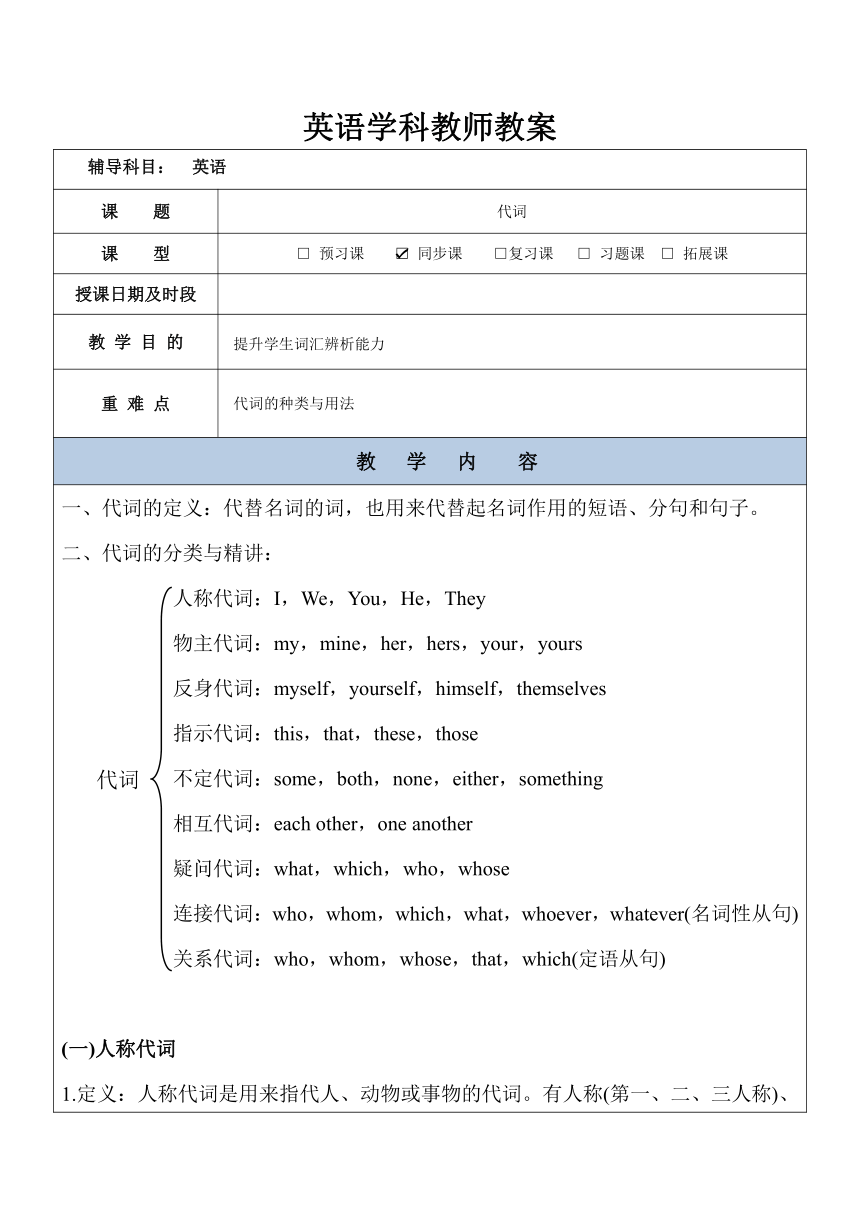 | |
| 格式 | zip | ||
| 文件大小 | 39.4KB | ||
| 资源类型 | 教案 | ||
| 版本资源 | 人教新目标(Go for it)版 | ||
| 科目 | 英语 | ||
| 更新时间 | 2022-04-17 10:33:36 | ||
图片预览

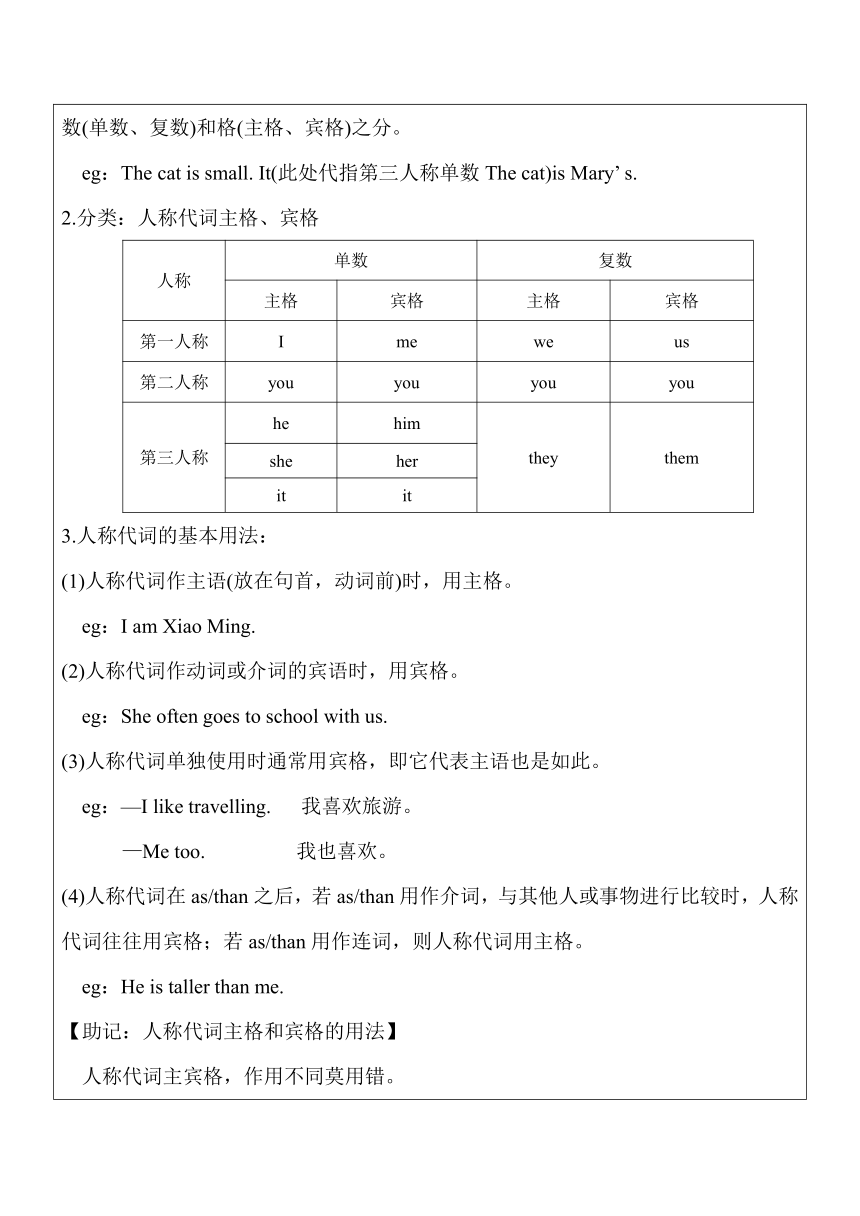
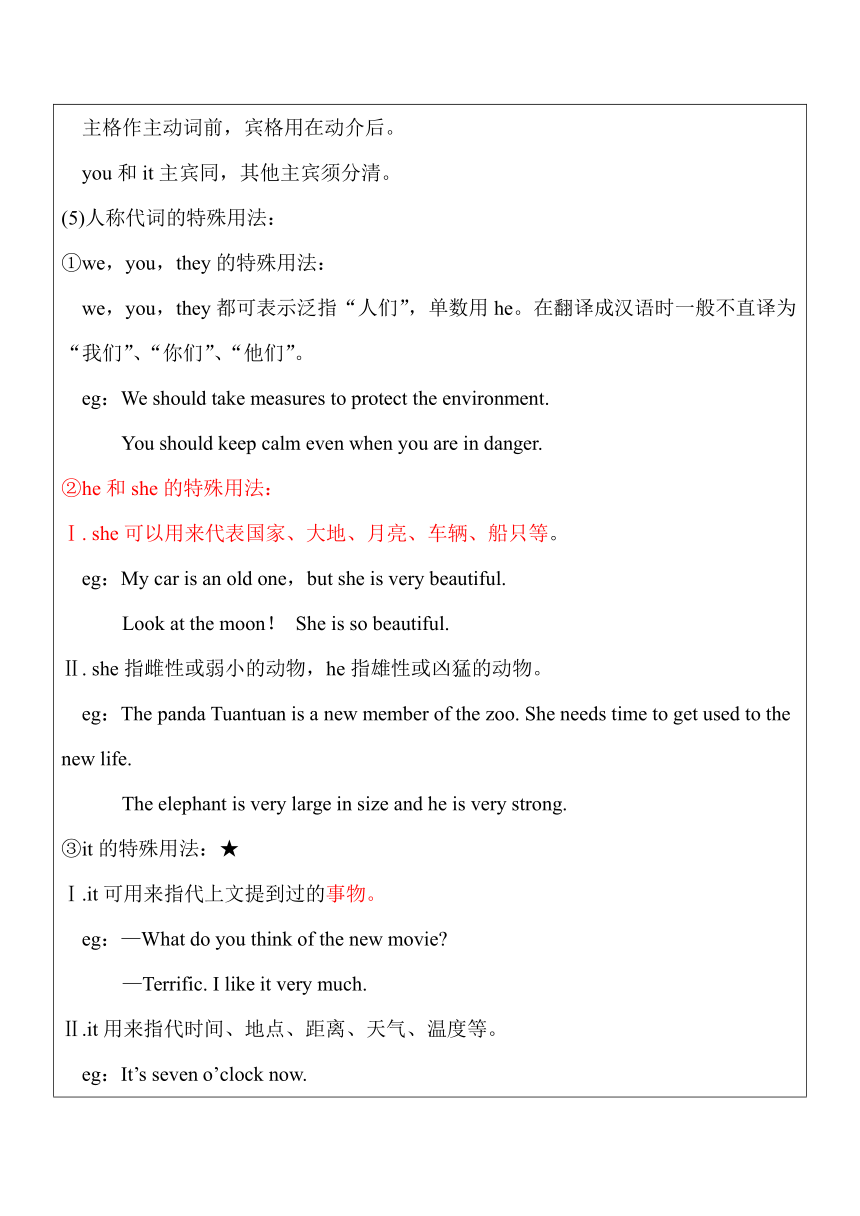
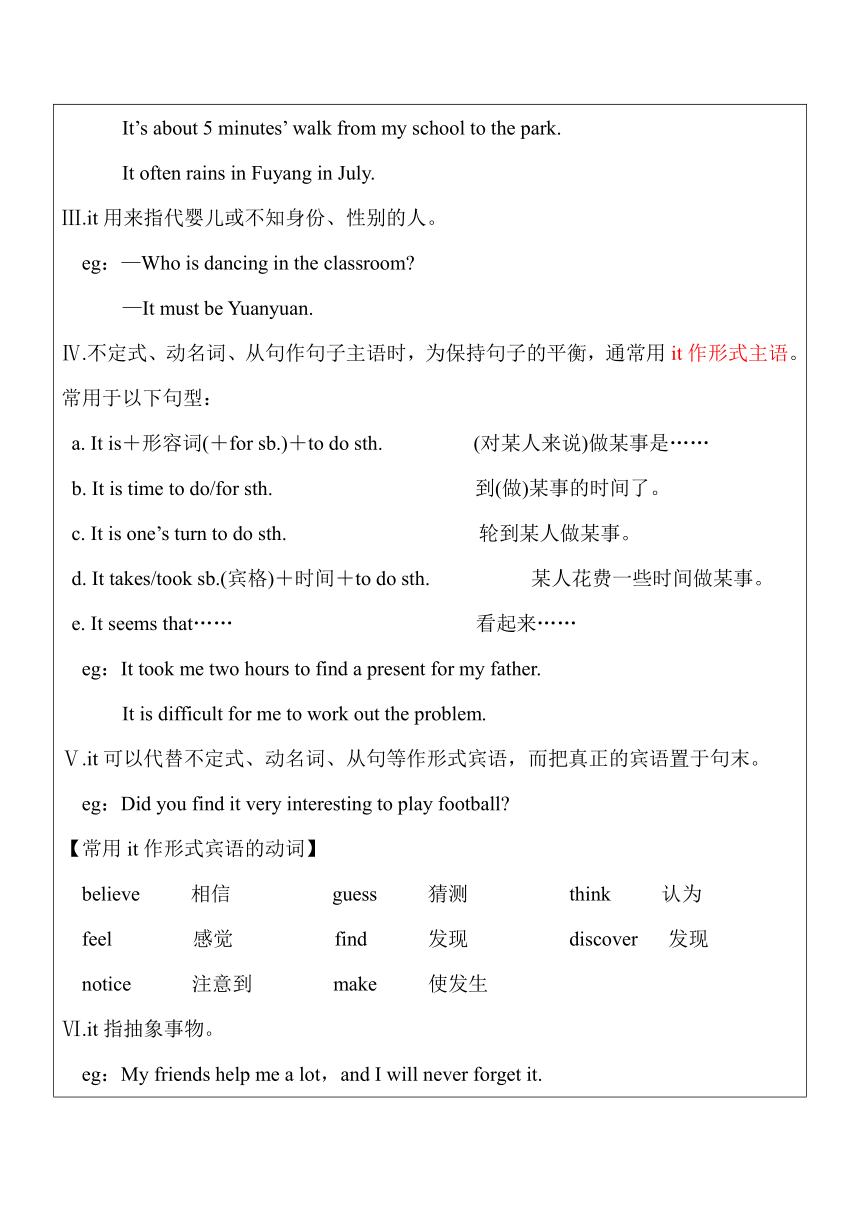
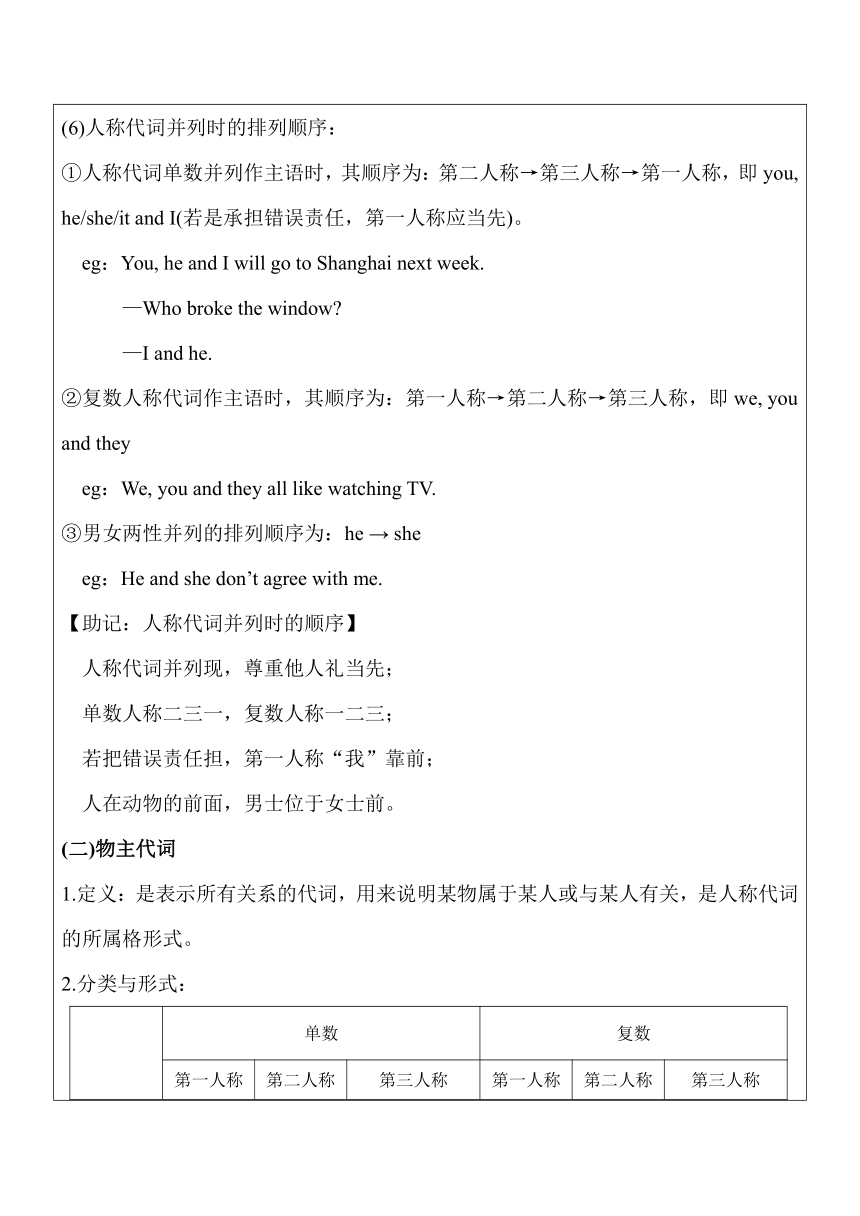
文档简介
英语学科教师教案
辅导科目: 英语
课 题 代词
课 型 □ 预习课 同步课 □复习课 □ 习题课 □ 拓展课
授课日期及时段
教 学 目 的 提升学生词汇辨析能力
重 难 点 代词的种类与用法
教 学 内 容
一、代词的定义:代替名词的词,也用来代替起名词作用的短语、分句和句子。 二、代词的分类与精讲: 人称代词:I,We,You,He,They 物主代词:my,mine,her,hers,your,yours 反身代词:myself,yourself,himself,themselves 指示代词:this,that,these,those 不定代词:some,both,none,either,something 相互代词:each other,one another 疑问代词:what,which,who,whose 连接代词:who,whom,which,what,whoever,whatever(名词性从句) 关系代词:who,whom,whose,that,which(定语从句) (一)人称代词 1.定义:人称代词是用来指代人、动物或事物的代词。有人称(第一、二、三人称)、数(单数、复数)和格(主格、宾格)之分。 eg:The cat is small. It(此处代指第三人称单数The cat)is Mary’ s. 2.分类:人称代词主格、宾格 人称单数复数主格宾格主格宾格第一人称Imeweus第二人称youyouyouyou第三人称hehimtheythemsheheritit
3.人称代词的基本用法: (1)人称代词作主语(放在句首,动词前)时,用主格。 eg:I am Xiao Ming. (2)人称代词作动词或介词的宾语时,用宾格。 eg:She often goes to school with us. (3)人称代词单独使用时通常用宾格,即它代表主语也是如此。 eg:—I like travelling. 我喜欢旅游。 —Me too. 我也喜欢。 (4)人称代词在as/than之后,若as/than用作介词,与其他人或事物进行比较时,人称代词往往用宾格;若as/than用作连词,则人称代词用主格。 eg:He is taller than me. 【助记:人称代词主格和宾格的用法】 人称代词主宾格,作用不同莫用错。 主格作主动词前,宾格用在动介后。 you和it主宾同,其他主宾须分清。 (5)人称代词的特殊用法: ①we,you,they的特殊用法: we,you,they都可表示泛指“人们”,单数用he。在翻译成汉语时一般不直译为“我们”、“你们”、“他们”。 eg:We should take measures to protect the environment. You should keep calm even when you are in danger. ②he和she的特殊用法: Ⅰ. she可以用来代表国家、大地、月亮、车辆、船只等。 eg:My car is an old one,but she is very beautiful. Look at the moon! She is so beautiful. Ⅱ. she指雌性或弱小的动物,he指雄性或凶猛的动物。 eg:The panda Tuantuan is a new member of the zoo. She needs time to get used to the new life. The elephant is very large in size and he is very strong. ③it的特殊用法:★ Ⅰ.it可用来指代上文提到过的事物。 eg:—What do you think of the new movie —Terrific. I like it very much. Ⅱ.it用来指代时间、地点、距离、天气、温度等。 eg:It’s seven o’clock now. It’s about 5 minutes’ walk from my school to the park. It often rains in Fuyang in July. Ⅲ.it用来指代婴儿或不知身份、性别的人。 eg:—Who is dancing in the classroom —It must be Yuanyuan. Ⅳ.不定式、动名词、从句作句子主语时,为保持句子的平衡,通常用it作形式主语。 常用于以下句型: a. It is+形容词(+for sb.)+to do sth. (对某人来说)做某事是…… b. It is time to do/for sth. 到(做)某事的时间了。 c. It is one’s turn to do sth. 轮到某人做某事。 d. It takes/took sb.(宾格)+时间+to do sth. 某人花费一些时间做某事。 e. It seems that…… 看起来…… eg:It took me two hours to find a present for my father. It is difficult for me to work out the problem. Ⅴ.it可以代替不定式、动名词、从句等作形式宾语,而把真正的宾语置于句末。 eg:Did you find it very interesting to play football 【常用it作形式宾语的动词】 believe 相信 guess 猜测 think 认为 feel 感觉 find 发现 discover 发现 notice 注意到 make 使发生 Ⅵ.it指抽象事物。 eg:My friends help me a lot,and I will never forget it. (6)人称代词并列时的排列顺序: ①人称代词单数并列作主语时,其顺序为:第二人称→第三人称→第一人称,即you, he/she/it and I(若是承担错误责任,第一人称应当先)。 eg:You, he and I will go to Shanghai next week. —Who broke the window —I and he. ②复数人称代词作主语时,其顺序为:第一人称→第二人称→第三人称,即we, you and they eg:We, you and they all like watching TV. ③男女两性并列的排列顺序为:he → she eg:He and she don’t agree with me. 【助记:人称代词并列时的顺序】 人称代词并列现,尊重他人礼当先; 单数人称二三一,复数人称一二三; 若把错误责任担,第一人称“我”靠前; 人在动物的前面,男士位于女士前。 (二)物主代词 1.定义:是表示所有关系的代词,用来说明某物属于某人或与某人有关,是人称代词的所属格形式。 2.分类与形式: 单数复数第一人称第二人称第三人称第一人称第二人称第三人称形容词性物主代词myyourhis/her/itsOuryourtheir名词性物主代词mineyourshis/hers/ itsOursyourstheirs含义我的你的他的/她的/它的我们的你们的他(她,它)们的
【助记:物主代词的形式】 物主代词分两家,形、名词性各一霸。 his,its无变化,my,mine记牢它。 其余变形规律化,形容词(性)后加尾巴(s)。 3.用法: (1)形容词性物主代词:相当于形容词,只能置于名词前作定语,其人称、数和性别的变化取决于其所指代的名词。 eg:The students are helping the old man clean his house now. 注意:形容词性物主代词后可加own,也可构成of one’s own结构,表示强调,意为“某人自己的”。 eg:I want to have my own free time. (2)名词性物主代词:起名词的作用,相当于“形容词性物主代词+名词”。 eg:May I use your pen Yours works better. 【总结】 形容词性物主代词后面必须接名词,名词性物主代词后面决不接名词。 练习:—Lucy,is this baseball bat —No, is over there. It must be Mike’s. A. your;my B. your;mine C. yours;my D. yours;mine (三)反身代词 1.定义:当表示动作回执到其执行者本身,用以加强语气的代词。 2.形式: 单数复数第一人称第二人称第三人称第一人称第二人称第三人称反身代词myselfyourselfhimself/herself/itselfourselvesyourselvesthemselves含义我自己你自己他/她/它自己我们自己你们自己他(她,它)们自己
【总结】 第一、二人称的反身代词由形容词性物主代词加-self或-selves构成;第三人称的反身代词由人称代词的宾格加-self或-selves构成。 3.用法: (1)可作动词或介词的宾语:反身代词作动词的宾语,表示动作的承受者就是动作的执行者;也可用在介词后作宾语,与句子主语互指。 eg:Boys,don’t lose yourselves in playing games. 孩子们,不要沉迷于玩游戏。【反身代词作宾语的常见搭配】 enjoy oneself 玩得愉快 help oneself to 随便吃喝 dress oneself 自己穿衣服 come to oneself 恢复知觉 devote oneself to 献身于 learn…by oneself 自学…… teach oneself 自学 for oneself 亲自,为自己 by oneself 独自 talk to oneself 自言自语 (2)反身代词在be,feel,look,seem等连系动词后作表语。 eg:He doesn’t seem himself today. 练习: My daughter was about 2 years old when she could walk by . A. her B. she C. hers D. herself (四)指示代词 1.定义:是用来指代或标记人或事物的代词,表示“这个/些,那个/些”。 2.分类: 指示代词用法例句this(these)用于指时间或空间上较近的事物Is this your pen These are my books.that(those)用于指时间或空间上较远的事物That dictionary is Mary’s. Are those your books
注意:在疑问句的回答中,用it代替this或that;用they代替these或those。 eg:—What is this 这是什么 —It is a pencil box. 这是一个铅笔盒。 3.用法:指示代词可在句中作主语、宾语、表语、定语等。 (1) that和those代替前面提到的东西,以避免重复这个名词。 eg:My seat is next to that of the mayor.(that=mayor’s seat)我的座位在市长座位旁边。 注意:that可代替前面提到的单数可数名词或不可数名词;those可代替复数可数名词,其后总有修饰语。 (2) this或that用来回指上文提到的事情,但若要指下文叙述的事情,通常要用 this。 eg:—She is a beautiful girl. 她是一个漂亮的女孩。 —Who said that 那是谁说的? I want to know this:Is she beautiful 我想知道这一点:她美吗 (3)在打电话时,通常用this指自己,用that指对方: eg:Hello! This is Jim. Is that John 喂,我是吉姆,你是约翰吗 (4)指示代词this,that和these在作主语时可指物也可指人,但作其他句子成分时只能指物,不能指人。而those作宾语后接定语从句时可以指人。而且只有that、those后面可以跟定语从句。 练习:—Mr. Han,how is the weather in Fuyang now,please —Actually,it is cooler than in Hainan. A. it B. that C. this D. those 解析:此处指代上文的不可数名词weather,特指“海南的天气”,应用that。 (五)不定代词 1.定义:不明确指代某个人、某个事物、某些人、某些事物的代词叫不定代词。不定代词可以代替名称和形容词,表示不同的数量概念。 注意:不定代词没有主格和宾格之分,在句中可作主语、表语、宾语和定语等。 2.分类: 例词分类句法功能every,other,no具有形容词性质只能作定语everyone,everybody,everything,someone, somebody,something,anyone,anybody,anything,no one,nobody,nothing,none,(the)others具有名词性质作主语、宾语和表语all,both,each,neither,either,many,much,(a)little,(a)few,other,some,any,one兼有形容词性质和名词性质作主语、宾语、表语同位语和定语
3.用法: (1)some与any的用法: ①some和any表示“一些”,作定语时既可以修饰可数名词,又可以修饰不可数名词。some通常用于肯定句中,any多用于否定句、疑问句中。 eg:Some rice in the bag has been sold out. 袋子里的一些大米已经卖出去了。(修饰不可数名词) Do you have any brothers or sisters 你有兄弟姐妹吗 (修饰可数名词) ②在表示请求、劝告、邀请、或不希望对方拒绝的疑问句中用some而不用any。 eg:Could you give me some water 请给我一些水好吗 ③any用于肯定句或条件状语从句时,表示“任何”。 eg:If you have any questions, please ask me. 如果你有问题,可以问我。 ④some和any可以用来修饰单数名词,some表示“某一”;any表示“任何的”。 eg:Any student can answer this question. 任何学生都可以回答这个问题。 Someday Chinese people will fly to the Mars. 某天中国人将会飞上火星。 (2) few,a few,little,a little的用法: 用法用于可数名词用于不可数名词表示肯定概念a few:虽少,但有几个a little:虽少,但有一点表示否定概念few:不多,几乎没有little:不多,没有什么
①这四个词或词组在句中都可作主语、宾语和定语。 eg:Few of us have been to Beijing. 我们中几乎没有人去过北京。(主语) I know little about the book. 我几乎不知道这本书的内容。(宾语) There is a little water in the bottle. 瓶子里有一些水。(定语) He has a few friends. 他有一些朋友。(定语) ②a little和little也可以用作副词,a little表示“有点,稍微”,little表示“很少”。 eg:I’m a little hungry. 我有点饿。(修饰形容词hungry) Let him sleep a little. 让他睡一会儿。(修饰动词sleep) Mary, go a little faster, please. 玛丽,请走快一点儿。(修饰副词比较级) 【总结】(a) few可与of连用,其后跟特指的复数可数名词或them,you,us; (a)little也可与of连用,但其后跟特指的不可数名词或it。 (3) both,all,none,either,neither的用法: ①both表示“两者都”,常用于“both…and…,两者都、既……又……”结构,可以作主语、宾语、定语和同位语;用于否定句表示部分否定,全部否定使用neither。 eg:They both are not workers. 他们两个不都是工人。 Both Carl and Jeff are good at playing football. 卡尔和杰夫都擅长踢足球。 注意:both作主语时,谓语动词使用复数形式;作主语的同位语时,位于行为动词之前,be动词、助动词、情态动词之后,。 eg:Both of them have been to Beijing. 他们两人都去过北京。 They all enjoyed it. 他们都喜欢它。 ②all侧重指三者或三者以上“都,全部,一切”,在句中可作主语、宾语、表语、定语和同位语;all于否定句时,表示部分否定,若表示全部否定则用none。 eg:All the students are on the playground. 所有的学生都在操场上。 Not all books are good. = All books are not good. 不是所有的书都是好书。 None of the books are good. 这些书都不是好书。 注意:all作主语指代人时,谓语动词使用复数形式;指代事情时,谓语动词一般使用单数;作同位语时,all在句中的位置与both相同。 eg:All goes very well. 一切进展非常顺利。 ③none意为“没有人,没有一个,一点儿也没有”,可作主语和宾语,不作定语;可与of连用。none指代可数名词作主语时,谓语动词用单数或复数形式均可,而指代不可数名词时,谓语动词必须使用单数形式。 eg:None of the books is/are mine. 这些书都不是我的。 None of the rubbish has been removed. 垃圾一点也没运走。 【none与no one的辨析】 no one意为“没有一个人”,常指人,仅用于指代单数可数名词。no one常用来回答以who提问的特殊疑问句,而none常用来回答以how many/much提问的特殊疑问句。 eg:—Who is absent from class today —No one,sir. —How much water do you have —None. 练习:We couldn’t buy anything because of the shops were open. A. all B. both C. nothing D. none ④either表示“两者中任何一个”,可作主语、宾语和定语;either作主语时,谓语动词应使用单数形式;作定语时,修饰单数名词。 eg:You can park on either side of the street. 你在街道的哪边停车都可以。 The two guests have arrived and either is welcome. 两个客人都到了,而且都受欢迎。 注意1:either常用于结构“either…or…”,意为“或者…或者…;要么…要么…”,谓语动词要用就近原则。 eg:Either he or I am to blame. 或者他或者我将受到责备。 注意2:either可作为副词,意为“也”,用于否定句的句末,不加逗号。 eg:He won’ t go and I won’t go either. 他不去,我也不去。 ⑤neither意为“两者都不”,常用于“neither…nor…,既不……也不……”结构,可作主语、宾语和定语。 eg:Neither of them can cook. 他们两个都不会做饭。 Neither he nor I am a doctor. 他和我都不是医生。 【总结】either与neither都跟与of连用,其后跟特指的复数可数名词或them,us,you等。 练习:—Where would you like to go tomorrow,Beijing or Shanghai — is OK. It’s up to you. A. Neither B. Either C. Both D. All (4) other,the other,others,the others,another的用法: ①other表示泛指,意为“另外的,其他的”,只能作定语,不能单独使用,后面必须要跟单数名词或复数名词。 eg:Where are his other books 他的另一些书在哪里 ②others表示泛指,意为“别的人或别的物”,相当于“other+复数可数名词”。不能作定语,必须单独使用,常用于“some……others”结构。 eg:Some are red, and others are black. 一些是红的,另一些是黑的。 ③the other表示特指,意为“两个中的另一个,剩下的一个”,常用于“one…the other…”结构。 eg:She has two sisters—one is a nurse, and the other is a teacher. 她有两个姐姐,一个是护士,另一个是老师。 ④the others表示特指,表示在一个范围内的其他全部,意为“其他全部,其余的”。 eg:In our class only Tom is English, and the others are Chinese. 我们班除了汤姆是英国人外,其他都是中国人。 ⑤another表示泛指,意为“另一个(指多个中的任何一个)”,可单独使用,也可接单数名词或名词复数,表示“另几个,再几个”。 eg:You can see another ship in the sea, can’t you 你能看见另一艘船在海里,不是吗 (5)one的用法: ①one表示泛指,可用来代替单数可数名词;ones用来代替复数可数名词。 eg:I am looking for a map, but I can’t find one. There are 20 old tables in our class. Our teacher wants to buy 10 new ones. ②one可指代不特定的人,表示“人,一个人,人们”。 eg:One should keep one’s word. 人应当信守承诺。 ③one(ones)可以和the,this(these),that(those)等词连用,表示特指的某(些)人或某(些)物。 eg:I don’t like that cell phone,the one you just showed me. ④表示具体的“一个人,一个事物”。 eg:Miss White is an English teacher,one who is very kind. 【one,it与that的辨析】 ①one表示泛指,复数形式为ones。可代替单数可数名词,与前面提到过的事物是同一类,但不是同一个,即“同类不同个”。 eg:Which jacket would you like,this one or that one ②it代替单数可数名词,指上文提到的同一个事物,即“同类又同个”。 eg:I can’t find my hat. I don’t know where I put it. ③that表示特指,复数形式为those。代替前面提到过的单数可数名词或不可数名词,它表示同一类而不是同一个。 eg:The population of China is larger than that of India. (6)each和every的用法: ①each指代或修饰单数可数名词,强调个体,可与of连用,多用两者或两者以上的场合。作主语时,谓语动词用单数。 eg:Each of them knows the whole thing. 他们每一个人都知道事情的全部经过。 ②every修饰单数可数名词,强调整体,不与of连用,用于三者或三者以上的场合。 every修饰名词作主语时,谓语动词用单数。 eg:Every student needs to be careful with their studies. 每个学生都需要认真对待学习。 ③表示“每……,每隔……”时,要用“every+基数词+名词”结构,其中every不能用each代替。 eg:The buses go every 10 minutes. 公共汽车每隔10分钟发一班车。 (7)复合不定代词的用法: ①定义:由some,any,every,no与one,body,thing一起构成的代词叫复合不定代词,如something,everybody,anyone,nothing等。由one和body构成的复合不定代词可相互换用。 ②some-类复合不定代词一般用于肯定句中,表示“某人/物”,也可用于表示希望得到肯定回答的疑问句中。 eg:I have something important to tell you. 我有一些重要的事情要告诉你。 You don’t have a drink. Can I get you something 你没有喝的东西了。需要我给你拿一些来吗 ③any-类复合不定代词常用于否定句、疑问句或条件句中,表示“某人/物”,也可用于肯定句中,表示“任何人/物”。 eg:Is there anything interesting in the newspaper ④every-类复合不定代词表示“所有人/物”,与否定词连用表示部分否定。 eg:Not everyone can work out the problem. 【everyone与every one的辨析】 everyone意为“每人,人人”,只指人不指物,后面不能跟of短语;every one意为“每个”,既可指人,也可指物,后面能跟of短语。 eg:Is everyone here today I have read every one of his book. ⑤当形容词修饰复合不定代词时,要放在复合不定代词的后面。 eg:Every day mom tries to cook something different for me. ⑥复合不定代词作主语时,谓语动词一般用单数。 eg:Listen!Somebody is singing in the next room. ⑦somebody和nobody还可用作名词,somebody意为“是个人物,感觉很重要”,nobody意为“无名小卒,小人物”。 eg:Paul feels like he is somebody. (六)相互代词 1.定义:表示相互关系的代词。 2.分类:each other与one another,意为“相互,互相”。 3.用法:传统语法认为each other主要用于两者之间,one another主要用于三者或三者以上,但现代英语中,两者常可换用。相互代词在句中只能作宾语。 eg:We often visit one another on weekends. After the match,the two players shook hands with each other. (七)疑问代词 1.定义:用来表示疑问或者构成疑问句的代词,一般位于句首。 2.分类与用法: ①who,whom的用法: 两者都意为“谁”,用来指人。其中who可用作主语、宾语和表语,whom只用作宾语。在介词后作宾语只能用whom。 eg:—Who is that man over there —He’s my uncle. To whom did you speak on the playground 注意:疑问代词充当主语时,谓语动词是用单数还是复数形式,要根据它们所代表的名词单复数形式确定。若数的概念不清楚,谓语动词多用单数形式。 ②whose的用法: whose意为“谁的”,既可置于名词前作定语,也可单独使用,作主语、宾语和表语。 eg:Whose book is this (作定语) Whose are those flowers (作表语) ③which的用法: which意为“哪一个,哪一些”,可用来指代人或物,可指可数名词单、复数,也可指不可数名词,在句中作主语、宾语和定语。 eg:Which animal do you like best —Which would you like to choose live in,Chengdu,Beijing or Shanghai —Chengdu,I think. 注意:which一般有特定的选择范围,而who和what则没有选择范围。 ④what的用法: Ⅰ.what的基本用法: what意为“什么”,可单独使用,也可放在名词前,既可指代或修饰单数、复数可数名词,也可指代或修饰不可数名词。在句中可作主语、宾语、表语和定语。 eg:What makes you so sad What are your reasons for leaving Ⅱ.what的习惯用法: a.“What be+主语 ”和“What do/does+主语+do ”可用于询问职业。 eg:What is your father =What does your father do 【注意】“Who be+主语 ”结构是用来询问身份的。 b.“What be+主语+like ”用于询问品行和天气状况,“What do/does+主语+look like ”用于询问外貌、长相。 eg:What is the weather like in your hometown —What is our English teacher like —She is kind. What does she look like c.“What about…… ”用于征求意见或询问对方的情况,相当于“How about……”。 eg:I’m going to visit my grandfather. What about you d.“What…for… ”或“What for ”用于询问原因和目的。 eg:—I am going to the supermarket. —What for We still have enough food in the refrigerator. e. “What if…… ”表示“建议、假设、征求意见”或“疑虑”。 eg:What if it rains while we are on the way 练习: 1. —The fridges are on sale in the supermarket today. —Really Let’s go and buy for our new kitchen. A. one B. it C. that D. them 2. —I like the two dresses,but I can only afford of them. —I suggest you take the white one. A. all B. both C. neither D. either 3. —Is that model plane —Yes,it’s . My sister sent it to me. A. your;my B. your;mine C. you;me D. yours;mine 4. Lucy has two cousins. One is quiet,and is noisy. A. another B. other C. the other D. others 5.The physics problem is too hard,so students can work it out. A. little B. few C. a little D. a few
辅导科目: 英语
课 题 代词
课 型 □ 预习课 同步课 □复习课 □ 习题课 □ 拓展课
授课日期及时段
教 学 目 的 提升学生词汇辨析能力
重 难 点 代词的种类与用法
教 学 内 容
一、代词的定义:代替名词的词,也用来代替起名词作用的短语、分句和句子。 二、代词的分类与精讲: 人称代词:I,We,You,He,They 物主代词:my,mine,her,hers,your,yours 反身代词:myself,yourself,himself,themselves 指示代词:this,that,these,those 不定代词:some,both,none,either,something 相互代词:each other,one another 疑问代词:what,which,who,whose 连接代词:who,whom,which,what,whoever,whatever(名词性从句) 关系代词:who,whom,whose,that,which(定语从句) (一)人称代词 1.定义:人称代词是用来指代人、动物或事物的代词。有人称(第一、二、三人称)、数(单数、复数)和格(主格、宾格)之分。 eg:The cat is small. It(此处代指第三人称单数The cat)is Mary’ s. 2.分类:人称代词主格、宾格 人称单数复数主格宾格主格宾格第一人称Imeweus第二人称youyouyouyou第三人称hehimtheythemsheheritit
3.人称代词的基本用法: (1)人称代词作主语(放在句首,动词前)时,用主格。 eg:I am Xiao Ming. (2)人称代词作动词或介词的宾语时,用宾格。 eg:She often goes to school with us. (3)人称代词单独使用时通常用宾格,即它代表主语也是如此。 eg:—I like travelling. 我喜欢旅游。 —Me too. 我也喜欢。 (4)人称代词在as/than之后,若as/than用作介词,与其他人或事物进行比较时,人称代词往往用宾格;若as/than用作连词,则人称代词用主格。 eg:He is taller than me. 【助记:人称代词主格和宾格的用法】 人称代词主宾格,作用不同莫用错。 主格作主动词前,宾格用在动介后。 you和it主宾同,其他主宾须分清。 (5)人称代词的特殊用法: ①we,you,they的特殊用法: we,you,they都可表示泛指“人们”,单数用he。在翻译成汉语时一般不直译为“我们”、“你们”、“他们”。 eg:We should take measures to protect the environment. You should keep calm even when you are in danger. ②he和she的特殊用法: Ⅰ. she可以用来代表国家、大地、月亮、车辆、船只等。 eg:My car is an old one,but she is very beautiful. Look at the moon! She is so beautiful. Ⅱ. she指雌性或弱小的动物,he指雄性或凶猛的动物。 eg:The panda Tuantuan is a new member of the zoo. She needs time to get used to the new life. The elephant is very large in size and he is very strong. ③it的特殊用法:★ Ⅰ.it可用来指代上文提到过的事物。 eg:—What do you think of the new movie —Terrific. I like it very much. Ⅱ.it用来指代时间、地点、距离、天气、温度等。 eg:It’s seven o’clock now. It’s about 5 minutes’ walk from my school to the park. It often rains in Fuyang in July. Ⅲ.it用来指代婴儿或不知身份、性别的人。 eg:—Who is dancing in the classroom —It must be Yuanyuan. Ⅳ.不定式、动名词、从句作句子主语时,为保持句子的平衡,通常用it作形式主语。 常用于以下句型: a. It is+形容词(+for sb.)+to do sth. (对某人来说)做某事是…… b. It is time to do/for sth. 到(做)某事的时间了。 c. It is one’s turn to do sth. 轮到某人做某事。 d. It takes/took sb.(宾格)+时间+to do sth. 某人花费一些时间做某事。 e. It seems that…… 看起来…… eg:It took me two hours to find a present for my father. It is difficult for me to work out the problem. Ⅴ.it可以代替不定式、动名词、从句等作形式宾语,而把真正的宾语置于句末。 eg:Did you find it very interesting to play football 【常用it作形式宾语的动词】 believe 相信 guess 猜测 think 认为 feel 感觉 find 发现 discover 发现 notice 注意到 make 使发生 Ⅵ.it指抽象事物。 eg:My friends help me a lot,and I will never forget it. (6)人称代词并列时的排列顺序: ①人称代词单数并列作主语时,其顺序为:第二人称→第三人称→第一人称,即you, he/she/it and I(若是承担错误责任,第一人称应当先)。 eg:You, he and I will go to Shanghai next week. —Who broke the window —I and he. ②复数人称代词作主语时,其顺序为:第一人称→第二人称→第三人称,即we, you and they eg:We, you and they all like watching TV. ③男女两性并列的排列顺序为:he → she eg:He and she don’t agree with me. 【助记:人称代词并列时的顺序】 人称代词并列现,尊重他人礼当先; 单数人称二三一,复数人称一二三; 若把错误责任担,第一人称“我”靠前; 人在动物的前面,男士位于女士前。 (二)物主代词 1.定义:是表示所有关系的代词,用来说明某物属于某人或与某人有关,是人称代词的所属格形式。 2.分类与形式: 单数复数第一人称第二人称第三人称第一人称第二人称第三人称形容词性物主代词myyourhis/her/itsOuryourtheir名词性物主代词mineyourshis/hers/ itsOursyourstheirs含义我的你的他的/她的/它的我们的你们的他(她,它)们的
【助记:物主代词的形式】 物主代词分两家,形、名词性各一霸。 his,its无变化,my,mine记牢它。 其余变形规律化,形容词(性)后加尾巴(s)。 3.用法: (1)形容词性物主代词:相当于形容词,只能置于名词前作定语,其人称、数和性别的变化取决于其所指代的名词。 eg:The students are helping the old man clean his house now. 注意:形容词性物主代词后可加own,也可构成of one’s own结构,表示强调,意为“某人自己的”。 eg:I want to have my own free time. (2)名词性物主代词:起名词的作用,相当于“形容词性物主代词+名词”。 eg:May I use your pen Yours works better. 【总结】 形容词性物主代词后面必须接名词,名词性物主代词后面决不接名词。 练习:—Lucy,is this baseball bat —No, is over there. It must be Mike’s. A. your;my B. your;mine C. yours;my D. yours;mine (三)反身代词 1.定义:当表示动作回执到其执行者本身,用以加强语气的代词。 2.形式: 单数复数第一人称第二人称第三人称第一人称第二人称第三人称反身代词myselfyourselfhimself/herself/itselfourselvesyourselvesthemselves含义我自己你自己他/她/它自己我们自己你们自己他(她,它)们自己
【总结】 第一、二人称的反身代词由形容词性物主代词加-self或-selves构成;第三人称的反身代词由人称代词的宾格加-self或-selves构成。 3.用法: (1)可作动词或介词的宾语:反身代词作动词的宾语,表示动作的承受者就是动作的执行者;也可用在介词后作宾语,与句子主语互指。 eg:Boys,don’t lose yourselves in playing games. 孩子们,不要沉迷于玩游戏。【反身代词作宾语的常见搭配】 enjoy oneself 玩得愉快 help oneself to 随便吃喝 dress oneself 自己穿衣服 come to oneself 恢复知觉 devote oneself to 献身于 learn…by oneself 自学…… teach oneself 自学 for oneself 亲自,为自己 by oneself 独自 talk to oneself 自言自语 (2)反身代词在be,feel,look,seem等连系动词后作表语。 eg:He doesn’t seem himself today. 练习: My daughter was about 2 years old when she could walk by . A. her B. she C. hers D. herself (四)指示代词 1.定义:是用来指代或标记人或事物的代词,表示“这个/些,那个/些”。 2.分类: 指示代词用法例句this(these)用于指时间或空间上较近的事物Is this your pen These are my books.that(those)用于指时间或空间上较远的事物That dictionary is Mary’s. Are those your books
注意:在疑问句的回答中,用it代替this或that;用they代替these或those。 eg:—What is this 这是什么 —It is a pencil box. 这是一个铅笔盒。 3.用法:指示代词可在句中作主语、宾语、表语、定语等。 (1) that和those代替前面提到的东西,以避免重复这个名词。 eg:My seat is next to that of the mayor.(that=mayor’s seat)我的座位在市长座位旁边。 注意:that可代替前面提到的单数可数名词或不可数名词;those可代替复数可数名词,其后总有修饰语。 (2) this或that用来回指上文提到的事情,但若要指下文叙述的事情,通常要用 this。 eg:—She is a beautiful girl. 她是一个漂亮的女孩。 —Who said that 那是谁说的? I want to know this:Is she beautiful 我想知道这一点:她美吗 (3)在打电话时,通常用this指自己,用that指对方: eg:Hello! This is Jim. Is that John 喂,我是吉姆,你是约翰吗 (4)指示代词this,that和these在作主语时可指物也可指人,但作其他句子成分时只能指物,不能指人。而those作宾语后接定语从句时可以指人。而且只有that、those后面可以跟定语从句。 练习:—Mr. Han,how is the weather in Fuyang now,please —Actually,it is cooler than in Hainan. A. it B. that C. this D. those 解析:此处指代上文的不可数名词weather,特指“海南的天气”,应用that。 (五)不定代词 1.定义:不明确指代某个人、某个事物、某些人、某些事物的代词叫不定代词。不定代词可以代替名称和形容词,表示不同的数量概念。 注意:不定代词没有主格和宾格之分,在句中可作主语、表语、宾语和定语等。 2.分类: 例词分类句法功能every,other,no具有形容词性质只能作定语everyone,everybody,everything,someone, somebody,something,anyone,anybody,anything,no one,nobody,nothing,none,(the)others具有名词性质作主语、宾语和表语all,both,each,neither,either,many,much,(a)little,(a)few,other,some,any,one兼有形容词性质和名词性质作主语、宾语、表语同位语和定语
3.用法: (1)some与any的用法: ①some和any表示“一些”,作定语时既可以修饰可数名词,又可以修饰不可数名词。some通常用于肯定句中,any多用于否定句、疑问句中。 eg:Some rice in the bag has been sold out. 袋子里的一些大米已经卖出去了。(修饰不可数名词) Do you have any brothers or sisters 你有兄弟姐妹吗 (修饰可数名词) ②在表示请求、劝告、邀请、或不希望对方拒绝的疑问句中用some而不用any。 eg:Could you give me some water 请给我一些水好吗 ③any用于肯定句或条件状语从句时,表示“任何”。 eg:If you have any questions, please ask me. 如果你有问题,可以问我。 ④some和any可以用来修饰单数名词,some表示“某一”;any表示“任何的”。 eg:Any student can answer this question. 任何学生都可以回答这个问题。 Someday Chinese people will fly to the Mars. 某天中国人将会飞上火星。 (2) few,a few,little,a little的用法: 用法用于可数名词用于不可数名词表示肯定概念a few:虽少,但有几个a little:虽少,但有一点表示否定概念few:不多,几乎没有little:不多,没有什么
①这四个词或词组在句中都可作主语、宾语和定语。 eg:Few of us have been to Beijing. 我们中几乎没有人去过北京。(主语) I know little about the book. 我几乎不知道这本书的内容。(宾语) There is a little water in the bottle. 瓶子里有一些水。(定语) He has a few friends. 他有一些朋友。(定语) ②a little和little也可以用作副词,a little表示“有点,稍微”,little表示“很少”。 eg:I’m a little hungry. 我有点饿。(修饰形容词hungry) Let him sleep a little. 让他睡一会儿。(修饰动词sleep) Mary, go a little faster, please. 玛丽,请走快一点儿。(修饰副词比较级) 【总结】(a) few可与of连用,其后跟特指的复数可数名词或them,you,us; (a)little也可与of连用,但其后跟特指的不可数名词或it。 (3) both,all,none,either,neither的用法: ①both表示“两者都”,常用于“both…and…,两者都、既……又……”结构,可以作主语、宾语、定语和同位语;用于否定句表示部分否定,全部否定使用neither。 eg:They both are not workers. 他们两个不都是工人。 Both Carl and Jeff are good at playing football. 卡尔和杰夫都擅长踢足球。 注意:both作主语时,谓语动词使用复数形式;作主语的同位语时,位于行为动词之前,be动词、助动词、情态动词之后,。 eg:Both of them have been to Beijing. 他们两人都去过北京。 They all enjoyed it. 他们都喜欢它。 ②all侧重指三者或三者以上“都,全部,一切”,在句中可作主语、宾语、表语、定语和同位语;all于否定句时,表示部分否定,若表示全部否定则用none。 eg:All the students are on the playground. 所有的学生都在操场上。 Not all books are good. = All books are not good. 不是所有的书都是好书。 None of the books are good. 这些书都不是好书。 注意:all作主语指代人时,谓语动词使用复数形式;指代事情时,谓语动词一般使用单数;作同位语时,all在句中的位置与both相同。 eg:All goes very well. 一切进展非常顺利。 ③none意为“没有人,没有一个,一点儿也没有”,可作主语和宾语,不作定语;可与of连用。none指代可数名词作主语时,谓语动词用单数或复数形式均可,而指代不可数名词时,谓语动词必须使用单数形式。 eg:None of the books is/are mine. 这些书都不是我的。 None of the rubbish has been removed. 垃圾一点也没运走。 【none与no one的辨析】 no one意为“没有一个人”,常指人,仅用于指代单数可数名词。no one常用来回答以who提问的特殊疑问句,而none常用来回答以how many/much提问的特殊疑问句。 eg:—Who is absent from class today —No one,sir. —How much water do you have —None. 练习:We couldn’t buy anything because of the shops were open. A. all B. both C. nothing D. none ④either表示“两者中任何一个”,可作主语、宾语和定语;either作主语时,谓语动词应使用单数形式;作定语时,修饰单数名词。 eg:You can park on either side of the street. 你在街道的哪边停车都可以。 The two guests have arrived and either is welcome. 两个客人都到了,而且都受欢迎。 注意1:either常用于结构“either…or…”,意为“或者…或者…;要么…要么…”,谓语动词要用就近原则。 eg:Either he or I am to blame. 或者他或者我将受到责备。 注意2:either可作为副词,意为“也”,用于否定句的句末,不加逗号。 eg:He won’ t go and I won’t go either. 他不去,我也不去。 ⑤neither意为“两者都不”,常用于“neither…nor…,既不……也不……”结构,可作主语、宾语和定语。 eg:Neither of them can cook. 他们两个都不会做饭。 Neither he nor I am a doctor. 他和我都不是医生。 【总结】either与neither都跟与of连用,其后跟特指的复数可数名词或them,us,you等。 练习:—Where would you like to go tomorrow,Beijing or Shanghai — is OK. It’s up to you. A. Neither B. Either C. Both D. All (4) other,the other,others,the others,another的用法: ①other表示泛指,意为“另外的,其他的”,只能作定语,不能单独使用,后面必须要跟单数名词或复数名词。 eg:Where are his other books 他的另一些书在哪里 ②others表示泛指,意为“别的人或别的物”,相当于“other+复数可数名词”。不能作定语,必须单独使用,常用于“some……others”结构。 eg:Some are red, and others are black. 一些是红的,另一些是黑的。 ③the other表示特指,意为“两个中的另一个,剩下的一个”,常用于“one…the other…”结构。 eg:She has two sisters—one is a nurse, and the other is a teacher. 她有两个姐姐,一个是护士,另一个是老师。 ④the others表示特指,表示在一个范围内的其他全部,意为“其他全部,其余的”。 eg:In our class only Tom is English, and the others are Chinese. 我们班除了汤姆是英国人外,其他都是中国人。 ⑤another表示泛指,意为“另一个(指多个中的任何一个)”,可单独使用,也可接单数名词或名词复数,表示“另几个,再几个”。 eg:You can see another ship in the sea, can’t you 你能看见另一艘船在海里,不是吗 (5)one的用法: ①one表示泛指,可用来代替单数可数名词;ones用来代替复数可数名词。 eg:I am looking for a map, but I can’t find one. There are 20 old tables in our class. Our teacher wants to buy 10 new ones. ②one可指代不特定的人,表示“人,一个人,人们”。 eg:One should keep one’s word. 人应当信守承诺。 ③one(ones)可以和the,this(these),that(those)等词连用,表示特指的某(些)人或某(些)物。 eg:I don’t like that cell phone,the one you just showed me. ④表示具体的“一个人,一个事物”。 eg:Miss White is an English teacher,one who is very kind. 【one,it与that的辨析】 ①one表示泛指,复数形式为ones。可代替单数可数名词,与前面提到过的事物是同一类,但不是同一个,即“同类不同个”。 eg:Which jacket would you like,this one or that one ②it代替单数可数名词,指上文提到的同一个事物,即“同类又同个”。 eg:I can’t find my hat. I don’t know where I put it. ③that表示特指,复数形式为those。代替前面提到过的单数可数名词或不可数名词,它表示同一类而不是同一个。 eg:The population of China is larger than that of India. (6)each和every的用法: ①each指代或修饰单数可数名词,强调个体,可与of连用,多用两者或两者以上的场合。作主语时,谓语动词用单数。 eg:Each of them knows the whole thing. 他们每一个人都知道事情的全部经过。 ②every修饰单数可数名词,强调整体,不与of连用,用于三者或三者以上的场合。 every修饰名词作主语时,谓语动词用单数。 eg:Every student needs to be careful with their studies. 每个学生都需要认真对待学习。 ③表示“每……,每隔……”时,要用“every+基数词+名词”结构,其中every不能用each代替。 eg:The buses go every 10 minutes. 公共汽车每隔10分钟发一班车。 (7)复合不定代词的用法: ①定义:由some,any,every,no与one,body,thing一起构成的代词叫复合不定代词,如something,everybody,anyone,nothing等。由one和body构成的复合不定代词可相互换用。 ②some-类复合不定代词一般用于肯定句中,表示“某人/物”,也可用于表示希望得到肯定回答的疑问句中。 eg:I have something important to tell you. 我有一些重要的事情要告诉你。 You don’t have a drink. Can I get you something 你没有喝的东西了。需要我给你拿一些来吗 ③any-类复合不定代词常用于否定句、疑问句或条件句中,表示“某人/物”,也可用于肯定句中,表示“任何人/物”。 eg:Is there anything interesting in the newspaper ④every-类复合不定代词表示“所有人/物”,与否定词连用表示部分否定。 eg:Not everyone can work out the problem. 【everyone与every one的辨析】 everyone意为“每人,人人”,只指人不指物,后面不能跟of短语;every one意为“每个”,既可指人,也可指物,后面能跟of短语。 eg:Is everyone here today I have read every one of his book. ⑤当形容词修饰复合不定代词时,要放在复合不定代词的后面。 eg:Every day mom tries to cook something different for me. ⑥复合不定代词作主语时,谓语动词一般用单数。 eg:Listen!Somebody is singing in the next room. ⑦somebody和nobody还可用作名词,somebody意为“是个人物,感觉很重要”,nobody意为“无名小卒,小人物”。 eg:Paul feels like he is somebody. (六)相互代词 1.定义:表示相互关系的代词。 2.分类:each other与one another,意为“相互,互相”。 3.用法:传统语法认为each other主要用于两者之间,one another主要用于三者或三者以上,但现代英语中,两者常可换用。相互代词在句中只能作宾语。 eg:We often visit one another on weekends. After the match,the two players shook hands with each other. (七)疑问代词 1.定义:用来表示疑问或者构成疑问句的代词,一般位于句首。 2.分类与用法: ①who,whom的用法: 两者都意为“谁”,用来指人。其中who可用作主语、宾语和表语,whom只用作宾语。在介词后作宾语只能用whom。 eg:—Who is that man over there —He’s my uncle. To whom did you speak on the playground 注意:疑问代词充当主语时,谓语动词是用单数还是复数形式,要根据它们所代表的名词单复数形式确定。若数的概念不清楚,谓语动词多用单数形式。 ②whose的用法: whose意为“谁的”,既可置于名词前作定语,也可单独使用,作主语、宾语和表语。 eg:Whose book is this (作定语) Whose are those flowers (作表语) ③which的用法: which意为“哪一个,哪一些”,可用来指代人或物,可指可数名词单、复数,也可指不可数名词,在句中作主语、宾语和定语。 eg:Which animal do you like best —Which would you like to choose live in,Chengdu,Beijing or Shanghai —Chengdu,I think. 注意:which一般有特定的选择范围,而who和what则没有选择范围。 ④what的用法: Ⅰ.what的基本用法: what意为“什么”,可单独使用,也可放在名词前,既可指代或修饰单数、复数可数名词,也可指代或修饰不可数名词。在句中可作主语、宾语、表语和定语。 eg:What makes you so sad What are your reasons for leaving Ⅱ.what的习惯用法: a.“What be+主语 ”和“What do/does+主语+do ”可用于询问职业。 eg:What is your father =What does your father do 【注意】“Who be+主语 ”结构是用来询问身份的。 b.“What be+主语+like ”用于询问品行和天气状况,“What do/does+主语+look like ”用于询问外貌、长相。 eg:What is the weather like in your hometown —What is our English teacher like —She is kind. What does she look like c.“What about…… ”用于征求意见或询问对方的情况,相当于“How about……”。 eg:I’m going to visit my grandfather. What about you d.“What…for… ”或“What for ”用于询问原因和目的。 eg:—I am going to the supermarket. —What for We still have enough food in the refrigerator. e. “What if…… ”表示“建议、假设、征求意见”或“疑虑”。 eg:What if it rains while we are on the way 练习: 1. —The fridges are on sale in the supermarket today. —Really Let’s go and buy for our new kitchen. A. one B. it C. that D. them 2. —I like the two dresses,but I can only afford of them. —I suggest you take the white one. A. all B. both C. neither D. either 3. —Is that model plane —Yes,it’s . My sister sent it to me. A. your;my B. your;mine C. you;me D. yours;mine 4. Lucy has two cousins. One is quiet,and is noisy. A. another B. other C. the other D. others 5.The physics problem is too hard,so students can work it out. A. little B. few C. a little D. a few
同课章节目录
- 词法
- 名词
- 动词和动词短语
- 动词语态
- 动词时态
- 助动词和情态动词
- 非谓语动词
- 冠词
- 代词
- 数词和量词
- 形容词副词及其比较等级
- 介词和介词短语
- 连词和感叹词
- 构词法
- 相似、相近词比较
- 句法
- 陈述句
- 一般疑问句和否定疑问句
- 特殊疑问句及选择疑问句
- 反意疑问句
- 存在句(There be句型)
- 宾语从句
- 定语从句
- 状语从句
- 主谓一致问题
- 简单句
- 并列句
- 复合句
- 主谓一致
- 主、表语从句
- 名词性从句
- 直接引语和间接引语
- 虚拟语气
- 感叹句
- 强调句
- 倒装句
- 祈使句
- 句子的成分
- 句子的分类
- 题型专区
- 单项选择部分
- 易错题
- 完形填空
- 阅读理解
- 词汇练习
- 听说训练
- 句型转换
- 补全对话
- 短文改错
- 翻译
- 书面表达
- 任务型阅读
- 语法填空
- 其他资料
